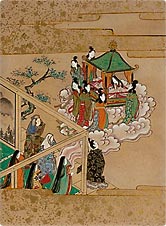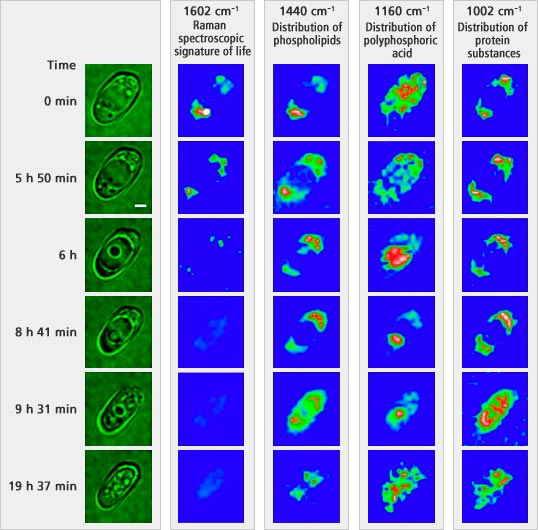The boundary between life and death is not as clear-cut as we would think, and therefore it is difficult to discern exactly where human life ends and death begins. The same is true for a single cell. Recently, however, it has been discovered that a certain faint light emitted from cells constitutes proof of life.
Fuji no Yama (Mount Fuji)

©Ryukoku University Omiya Library
Before returning to the moon, Kaguya Hime* (the Shining Princess) left behind an elixir of eternal life and a letter, as gifts to console the Emperor, who had fallen in love with her. On receiving these gifts, the Emperor responded by writing a poem in reply expressing his great sorrow:
“What use is it, this elixir of eternal life, to one who floats in tears because he cannot meet her again?”
He was unable to deliver the letter to Kaguya Hime, however, as she had returned to the moon. The Emperor thus commanded that the letter to Kaguya Hime and the elixir of eternal life be taken up the highest mountain possible and burned. A legion of soldiers climbed the mountain and burned the gifts, and it is said that even today the resulting smoke can be seen rising up into the clouds. The mountain—the highest in all Japan—thus came to be known as Fuji no Yama—the “Mountain that Swarms with Soldiers.” There are also a number of other suggested origins for Mount Fuji's name based on possible meanings of the word “Fuji,” such as “Mountain of Eternal Life,” after the elixir of eternal life that was burned there.
What sets the gods apart from mortal men? They live on and do not encounter death. Kaguya Hime, who left behind an elixir of eternal life before returning to the moon, was a goddess in the eyes of people on the earth seeing her off.
So where does life end and death begin? Even to modern science, the boundary between life and death remains unclear. However, proof of life, a certain light, has been discovered in cells, and a new definition of life has emerged.
- *A famous Japanese legend, the Tale of the Bamboo Cutter, relates how Kaguya Hime, who is from the moon, is discovered in a bamboo stalk in the form of a baby, is raised by the elderly couple who find her, and then—despite being courted by noblemen—returns to the moon.
Molecular fingerprints
What is meant by the words “living” and “life”?
Biologists have long been trying to find an answer to this question. Essentially, it results in investigating the behavior of the molecules of which cells are comprised, and this has given rise to a new field of study, known as molecular biology, which dates back approximately 60 years. Completely unrelated to this trend, however, there are also some researchers who are independently developing research methods for pinning down the mysteries of life that involve the investigation of molecular oscillation.
Hiro-o Hamaguchi, Professor at the University of Tokyo, is a researcher specializing in chemistry. Present day chemistry deals with the nano scale (one billionth of a meter) realm. Professor Hamaguchi believes, however, that chemistry will deal with gradually larger scales, and will ultimately make inroads into the domain of life. This being the case, what could be achieved by applying the techniques of chemistry to research into life? Pursuing this line of thought, Professor Hamaguchi considered using Raman spectroscopy, as used in the field of physics and chemistry, to look at life.
The Raman spectroscopy began with Raman light discovered in 1928 by the Indian physicist Chandrasekhara Raman. A laser is directed at an object and the weak light that is dispersed—the Raman light—is observed. The Raman light is referred to as a “spectral fingerprint,” since it represents an extremely sharp observation of the oscillating motion exhibited by molecules, thus it is able to distinguish each molecule individually.
“Since the Raman spectrum is not obstructed by the water that is present in most living creatures, Raman spectroscopy is an effective means of observing life. If a weak laser is used, it is possible to observe a live organism without affecting it,” the professor comments.
Professor Hamaguchi and his colleagues first attempted to use Raman spectral analysis on a living creature in 2000. Before then, very few people had used this technique to observe life. However, looking at the activity of “live” creatures at the molecular level using Raman spectral analysis was an attractive proposition, and Professor Hamaguchi and his colleagues became the first people ever to successfully observe living cells fragmenting in real time. “Were the cells really alive or not? This was not known until they were observed fragmenting in real time,” he says.
Until what point is a cell alive and at what point does it die? In fact, even in biology there was no clear definition. In general, it was not known that “cell death” had occurred until the cell completely lost its functional capability and the cell wall broke down, allowing a stain to enter the inside of the cell. In other words, a considerable time would elapse from the point at which a cell died until the point at which it was known to be dead. The threshold between cell life and cell death was unclear.
Dancing breakers
The process of cellular death takes place over a period of hours. After six hours, dancing bodies emerge in the heart of the cell. After eight hours and 50 minutes, dancing bodies stops moving. After nine hours and 31 minutes, the vacuoles break down and the interior of the cell collapses (optical microscope photographs).
The brewers at sake manufacturers know certain things from experience. If large lumps appear in yeast cells, fermentation slows to a near standstill. These lumps suddenly appear in cavities known as vacuoles of undernourished yeast, and move around as if they were dancing. (This movement, known as Brownian motion, is caused by thermal motion in liquid.) For this reason, they have been named “dancing bodies.” When these dancing bodies appear, cell activity virtually ceases. Soon the vacuoles break down, the dancing bodies cease to dance, and the cell is on course to die.
Although there was conjecture that the dancing bodies actually consisted of a substance known as polyphosphoric acid, their composition had not been clearly identified. Using Raman spectroscopy, Professor Hamaguchi and his colleague Yasuaki Naito demonstrated definitively that these bodies were in fact comprised of polyphosphoric acid, and moreover that it was in a crystalline state. But still, the dancing bodies remain shrouded in mystery. “We do not understand the mechanism that yields such large crystals so quickly—that is, in the space of a minute or less,” says Professor Hamaguchi. To begin with, it is not even understood why the dancing bodies appear immediately before the cell dies.

Inside the single living yeast cell, mitochondria localized at two points emit the “Raman spectroscopic signature of life” (with a frequency shift of 1602 cm-1). The red points indicate areas where the Raman spectroscopic signature of life is emitted strongly.
In a series of observations, Professor Hamaguchi and another colleague Yu-San Huan detected an unknown Raman light—but only while observing living cells. The newly discovered Raman light has wavelengths that had never been observed from any substance up to that time. In other words, the observations showed that cells contain an unknown substance.
This Raman light was found in small organelles (cell organs) inside cells that are known as mitochondria, which carry out respiration and produce energy. It appears that the unknown substance is somehow related to respiration.
It was also observed that when there are nutrients around the mitochondria, this light is emitted vigorously, but that when the nutrients run out, the light becomes weak, the cells die, and the light is extinguished. In other words, this light can only be observed while the cells are living. Professor Hamaguchi and his colleagues named this light the “Raman spectroscopic signature of life.”
The timing at which the light then disappears corresponds to the appearance of the “dancing bodies”—at the time when the cell dies. It became clearer than ever before that the Raman spectroscopic signature of life signifies that a cell is alive—as long as this light is visible, the cell is definitely alive.

It can be verified that the "Raman spectroscopic signature of life" virtually disappears when the dancing bodies appear after six hours. (Right 4 columns: Raman spectroscopic photographs. Extreme left: Optical microscope photographs)
A molecular message
Prior to this, there had been no clear definition of cell death; however, the Raman spectroscopic signature of life, which constitutes proof of life, has made it possible to discern the beginnings of cell death at a very early stage. The threshold between life and death has been revealed through the power of chemistry.
It is Professor Hamaguchi's conjecture that the Raman spectrum indicator of life is emitted from an intermediate substance that is produced by the mitochondria during the process of respiration. That is to say, the molecules in this intermediate substance, which are only produced while the mitochondria are carrying out respiration within the cell, emit the light that comprises the Raman spectroscopic signature of life. At the point where the functions of life cease and respiration ends, this intermediate substance disappears as well. As a result, the professor claims, the light that constitutes proof of life also goes out.
Humans have long searched to discover what it is that constitutes life. This led to the development of molecular biology, which searches for answers at the molecular level. However, no one had applied Raman spectroscopy techniques, as used for the observation of molecules, to the observation of life itself. It is here that the truly significant development resides.
There are probably some who think that this type of research is pure biology. According to Professor Hamaguchi, however, this too is essentially chemistry.
“It is said that the light seen through a spectroscope represents a molecular message,” he says. “As a romantic, I was charmed by this saying and took up chemistry as a result.” In the future, the mysteries of life will likely be revealed more quickly, thanks to the use of these molecular messages.
Editorial contributor / Date of article posted
Professor Hiro-o Hamaguchi, majoring in chemistry, of the University of Tokyo / March 2008

